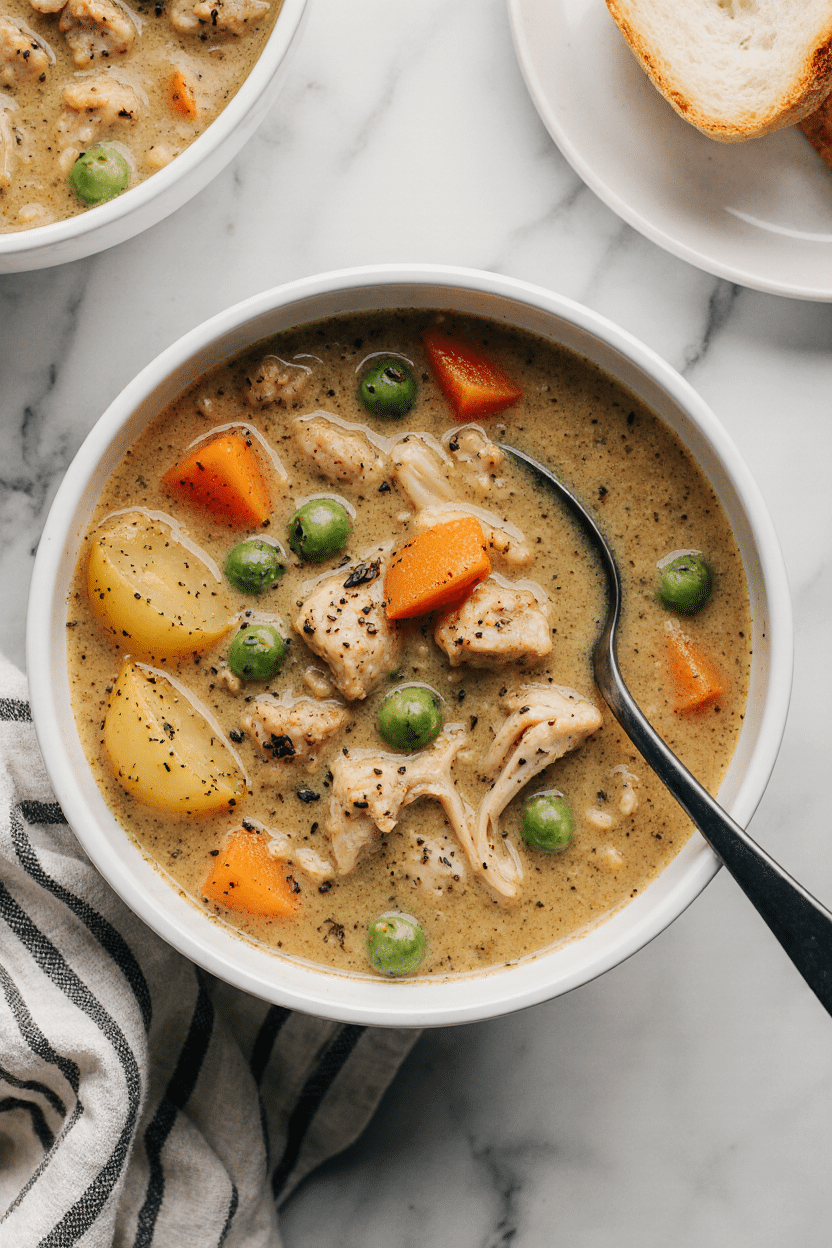Overview of Slow Cooker Chicken Stew
Slow Cooker Chicken Stew is one of those timeless comfort dishes that brings together the essence of home-cooked meals and the ease of modern convenience. Ideal for busy individuals and families alike, this dish not only satisfies the appetite but also provides a wholesome, nutritious meal without the need for constant supervision. Utilizing a slow cooker allows the ingredients to meld together over time, developing deep, rich flavors while maintaining a tender texture that’s hard to replicate with quicker cooking methods.
Chicken stew in the slow cooker generally includes a medley of hearty vegetables like carrots, potatoes, celery, and onions combined with chunks of tender chicken, all simmered slowly in a seasoned broth. The result is a warm, comforting bowl of goodness perfect for colder seasons or whenever you’re in the mood for something nourishing and filling.
The Appeal of Slow Cooker Meals
One of the primary reasons slow cooker meals have become so popular is their practicality. They offer the opportunity to prepare everything in the morning or during a lunch break, allowing the meal to cook unattended for several hours. This means you return home to a finished, aromatic dish that’s ready to be served. It’s a method that supports meal planning and simplifies dinner time, especially during hectic weekdays.
Slow cooker recipes like this chicken stew are also extremely adaptable. You can easily tweak ingredients to accommodate dietary restrictions or personal taste preferences. Whether you’re following a low-sodium diet, avoiding gluten, or looking to include more vegetables in your meals, this stew provides a perfect base for customizations.
Flavor Profile and Texture
The flavor of slow cooker chicken stew is robust and deeply satisfying. As the chicken simmers for several hours, it becomes melt-in-your-mouth tender, soaking up the savory broth enriched with herbs like thyme and rosemary. Vegetables, too, undergo a transformation—turning soft but not mushy, releasing their sweetness into the broth and creating a multi-dimensional taste.
Tomato paste or diced tomatoes may sometimes be added for an extra layer of acidity and richness, balancing the dish perfectly. The use of flour or cornstarch as a thickening agent ensures the stew has a hearty, stew-like consistency instead of a thin soup. Garnishing with fresh parsley or herbs adds a burst of freshness that contrasts wonderfully with the depth of flavor in the dish.
Nutrition and Health Benefits
Slow Cooker Chicken Stew is not only comforting but also nutritious. Chicken is a lean protein that supports muscle growth and repair, while vegetables contribute essential vitamins, minerals, and fiber. When made with low-sodium broth and minimal oil, this dish becomes an excellent heart-healthy option.
Using bone-in chicken adds a dose of natural collagen and minerals, enhancing both the nutritional value and flavor of the stew. You can also make this stew dairy-free or gluten-free with very minor adjustments, making it suitable for a wide range of diets.
Another advantage of slow cooker cooking is the minimal need for added fats. Because the dish is covered and cooked slowly, the need for oil is reduced, yet the ingredients remain moist and flavorful. This is an excellent way to control calorie intake while still enjoying a deeply satisfying meal.
Cultural Roots and Global Variations
Chicken stew appears in culinary traditions across the world, from French “Coq au Vin” to Caribbean-style stews filled with bold spices. The slow cooker version is particularly common in North American kitchens where the appliance is a household staple. Its global appeal lies in its simplicity and adaptability. Many cultures incorporate local spices, root vegetables, and herbs, turning the basic chicken stew into something uniquely their own.
In Latin American households, for example, you might find the stew infused with cumin, oregano, and bell peppers. In the Mediterranean region, olives, tomatoes, and lemon juice are often added. In Asian versions, ingredients like ginger, soy sauce, and green onions lend a completely different yet equally delicious flavor profile. The slow cooker adapts beautifully to all these variations, making it a globally beloved cooking method.
Best Occasions to Serve
This stew is an excellent meal for a wide range of occasions. It’s a favorite for family dinners, especially in colder months, when something warm and filling is desired. It also works well for entertaining guests, as it can be made in large quantities and kept warm throughout the evening.
Its make-ahead nature also makes it perfect for meal prep and freezer meals. A large batch can be divided into smaller portions and stored for future lunches or dinners, maintaining its flavor and texture upon reheating. It’s also a go-to dish during the holidays or busy seasons when time is limited but you still want to serve a homemade meal.
Pairings and Serving Suggestions
Slow Cooker Chicken Stew pairs wonderfully with a variety of sides. A thick slice of crusty bread is perfect for soaking up the flavorful broth. It also complements simple rice, mashed potatoes, or even egg noodles, depending on your preferences. For a lighter option, you can serve it alongside a crisp green salad or roasted vegetables.
Some enjoy topping their stew with a spoonful of sour cream or a sprinkle of grated cheese for added richness. Fresh herbs such as parsley, dill, or chives bring brightness and color to the dish, making it even more appealing when served.
For drinks, this dish goes well with dry white wines such as Sauvignon Blanc or a light-bodied red like Pinot Noir. Non-alcoholic options include sparkling water with lemon or a warm mug of herbal tea.
Storage and Reheating Tips
One of the biggest advantages of slow cooker meals is how well they store. Slow Cooker Chicken Stew can be refrigerated for up to 4 days in an airtight container. Its flavors often deepen over time, making leftovers even more enjoyable.
To freeze, allow the stew to cool completely before portioning into freezer-safe containers. It can last up to 3 months frozen. When reheating, it’s best to thaw it overnight in the refrigerator and then warm it on the stove over medium heat or in the microwave. Add a splash of broth or water if needed to restore the consistency.
Troubleshooting Common Issues
If your stew turns out too watery, a quick fix is to create a flour or cornstarch slurry and stir it in during the last half hour of cooking. Alternatively, remove the lid and let it simmer on high for 20-30 minutes to reduce.
If the chicken is too dry or stringy, it may have been overcooked. Using chicken thighs instead of breasts often helps, as thighs retain moisture better during long cooking periods. Also, cutting the vegetables into even-sized chunks ensures uniform cooking, preventing some ingredients from turning mushy while others remain firm.
Customizations and Variations
Slow Cooker Chicken Stew is endlessly customizable. You can swap the chicken for turkey, or even plant-based proteins like chickpeas or lentils for a vegetarian version. Want a richer flavor? Add a splash of heavy cream or coconut milk. Craving more spice? Try stirring in chili flakes or a bit of smoked paprika.
You can also make this dish seasonal by incorporating vegetables like squash in fall, green beans in spring, or corn in summer. Each variation brings something unique to the dish, allowing you to make it again and again without ever getting bored.
Conclusion
Slow Cooker Chicken Stew is a masterclass in simplicity, flavor, and nutrition. With minimal prep and effort, it delivers a rich, hearty meal that satisfies the soul and nourishes the body. It stands as a testament to how a few humble ingredients can come together to create something truly special.
Whether you’re a seasoned home cook or a beginner looking for a reliable weeknight meal, this stew fits the bill. Its forgiving nature, adaptability, and make-ahead convenience ensure it remains a beloved staple in many households. Warm, hearty, and full of flavor, this dish invites you to slow down and savor the comfort of a home-cooked meal, one spoonful at a time.






